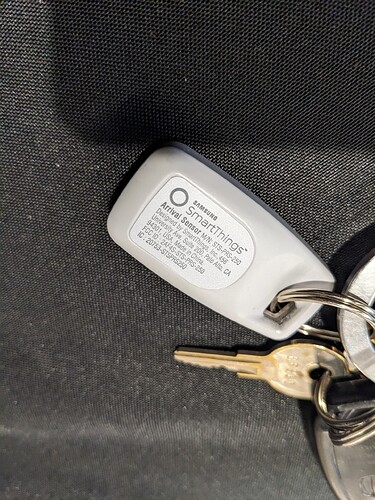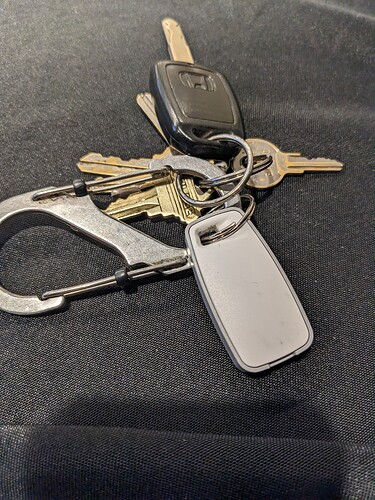And this "statistic" arises from what? Hard data? Or your perception?
I'm not looking to start an argument, so I'll explain what I meant/mean.
I said, "so many" are having an issue. That's certainly not a statistic. However, this message thread with more than a few people (many?) posting about their issues with Hubitat GeoFencing / Presence indicates an issue. It may or may not be a majority of Hubitat users that are having this issue, but I didn't say it was a majority of them - because I certainly don't know that it is or isn't. I just know it's more than a few - me included. So, I said, "so many".
Now, to be fair, I had similar issues with SmartThings too when I was using that platform. That's why I used webCoRE Presence then and why I continue to use it now on Hubitat. For me, it's been multitudes better than Hubitat's presence and pretty much rock solid - just by changing the software.
The larger point is that, as indicated in this and other threads I've seen about this topic, 'many' Hubitat users also choose to use alternative GeoFencing / Presence software to obtain reliable results.
I sometimes have a lag in the homekit presence. Not always, but most of the time that it happens, it's my spouse's phone, not mine. I haven't figured out why, other than maybe just a poor wifi signal.
Are you using a homekit hub? Or just the phone? What's the radius of your geolocation field?
Long time HE user, I read the forums often, but rarely comment.
I use HE for the same reasons I don't use other home automation systems. HE has one variable.. the hub. If I never touched it again, conceivably it would keep chugging along to the end of time.
About a year ago I set up notifications using both my wife's and my phone to get a notification every time one of us left the geo-fence. It works, but not with the kind of consistency that I would rely on. There are just too many variables, most of them rooted in the fact that the phone manufacturers and platforms love to move fast and break things. And there is zero chance that I'm going to put up with constantly babysitting the settings on our Android phones to make sure everything is "just so".
If our life-style ever changes to the point that we need something dependant on presence, I'll use a number pad.
This is probably 'too little, too late' but I wanted to add my $.02 to the topic
I'm a mobile developer who's worked on geofence apps for both iOS and Android and getting presence to 'just work' requires a lot of effort/testing and is continuously changing over time. The below post kind of sums it up nicely:
Since I've spent a lot more time working on Android recently I'll use it as my example -- but the same applies to iOS (which is even more aggressive at keeping things from running in the background)
Google has a guide on setting up a geofence.. you give the OS a location to monitor and it will 'wake' your app and deliver an event when you ENTER/EXIT that location.. simple! ![]()
The problem is -- this alone simply won't work reliably on many devices.. it works great for Google Pixel devices, which accounts for %.06 of Android devices. Other manufacturers like Samsung (34%) have their own logic for keeping apps from running in the background. It makes sense, the fewer apps running, the longer your battery will last!
Also keep in mind that the OS is looking at how often you open a particular app.. if you open Facebook often (for example), the OS might let this app do more in the background. But, if you don't ever open your Hubitat app the OS might think you're not using it and limit what it can do in the background..
Most devices do have a way to exclude apps from this 'battery optimization'. Once this is disabled, the app should get notified when you ENTER/EXIT the geofence.. but even this isn't 100% reliable with my testing.
There's several other tricks that apps like Life360 do to get the OS to start it.. things like using activity detection (which will notify your app when you're DRIVING, for example). Also, it's important that you show a system notification when running in the background to prevent the OS from stopping your app.
Finally, once the app knows the device is home/away, the next step is to notify Hubitat Hub. An app only gets a few seconds to run after it gets that ENTER/EXIT event. Since the device could be sitting idle / screen off it's possible it's not connected to the Internet either. So, the app needs to ensure any request will be re-tried if it fails.
My kids use Life360 and it's very reliable.. how? probably because they've spent TONS of time testing on both platforms so they've been able to use every tweak possible across each version of the OS.
I personally use Android (Samsung S22) and I also had presence issues using the native Hubitat Android app. So, I added my own geofence logic into my dashboard app and I spent a lot of time testing & tweaking it to get it just right. I've had it running for months now and I don't think it's ever missed a presence change.. so at least for me it's been very reliable. Does that mean it's going to work 100% for every Android device/OS out there? Probably not.. like most things it probably could but would just need to be well tested with that device/OS.
Long-story short - I don't blame Hubitat devs for presence not being reliable across Android and iOS as I've seen first-hand how much time it takes to get this working right.
That said, from a users perspective I understand how important presence is to the platform. My security cameras get enabled when I leave the house so I really need it to work.
There could/should be some ways to connect up a 3rd party app like OwnTracks or Life360 to the Hub's mode manager. Both work on iOS and Android and should be pretty reliable. I think many here would prefer OwnTracks since it can talk directly to your Hub and not some 3rd party server. It's not as easy to setup as the native Hubitat app though so maybe someone could post a nice guide on how to do this.. I'm sure it would involve installing this Hub driver and then connecting it to Mode Manager somehow.
My experience is limited to 3 geofencing apps on iPhones. My old home automation system, Geofency and Hubitat. The first two just work out of the box, no issues what so ever. Hubitat doesn't.
There maybe issues with other phones but it is possible to get geofencing working on iPhones.
I'm using an apple TV as a hub. The geolocation radius is rather large, but I thought homekit just used when your phone attached to the wifi signal.
This is great info, @jpage4500 , thank you.
It's clear to me that Hubitat lacks sufficient resources (devs) to track OS changes and make/keep this working, which feeds my initial proposal, make it work or dump it. Out of all the comments on this and other threads, I remember seeing ONE comment that this is working well for that person. I propose dumping GeoFencing from the mobile Hubitat apps and recommending Geofency or another option that actually works. At least it's an honest approach instead of ignoring the issue. How many wasted hours are spent by users on this before getting to these threads and finally giving up?
100% agree . . . . I am new to Hubitat and I wasted many hours trying to get the app to work. Thought I was doing something wrong!
This isn’t something they leave up to users.
But if it was, I would vote no on this proposal.
As OP, here's an update:
It's April 5th, my original posting is from last December, and nothing has changed, certainly this has not been fixed.
Despite my offer to help, Hubitat support is ignoring me. (Guess I've been blacklisted)
From an outsiders viewpoint, I'd guess Homekit, Hub v8, Matter, etc are absorbing resources and this just isn't a priority.
My offer to help still stands though.
I just recently bought a couple of the Samsung arrival sensors off Amazon in refurbished like new condition and this problem is now solved for me entirely! These things are amazing!
Battery life in these aren't great. Look up the aa battery hack for these. I have 3 or 4 of them.
Agree battery life generally sucks, but if the device is kept on a keychain, a AA battery case is a pretty bulky add-on. That works best for those that have put the presence sensor in their car.
I haven't read this entire thread, just just jumped to the last page or two.
I honestly feel using mobile devices for presence this is just the nature of the beast. Smartthings presence sucked too.
So many different phone models, operating systems, versions, security patches, battery saving modes, etc. It's all mediocre at best.
That has almost always been my experience with using my iPhone as a mobile presence sensor (with Hubitat or otherwise). Even when using built-in apps like Apple Home or Shortcuts.
I had been fighting this presence issue for years. I bought one of those SmatThings sensors a couple months ago for my Wife's keys since she never opens the Hubitat app, it never worked reliably for presence. Since I purchased this, it has worked reliably 99.9% of the time. It disappeared once in the middle of the night for a few minutes ONE time, and since then it's been bulletproof.
I guess I haven't had them long enough to run into battery issues yet. After the success with hers, I got myself one too and I love them.
I also have had less than optimal experience with our (2) iPhones for presence and geo-location functionality with both SmartThings and Hubitat. However, once I started using webCoRE presence with SmartThings and now Hubitat, presence and geo-location have worked 99.9% of the time.
FWIW, I have used a purpose-built geofencing app on Android for one year (2019-2020), and on iPhones since then. I cannot recall when it last failed. And, I'm lucky in that Apple Home + Shortcuts has been equally robust.
What I dislike about Apple Home is that I can only set a geofence around my home, while the other application I have lets me set multiple locations, as well as geofences that are concentric circles - which let me determine the direction in which I am traveling.



